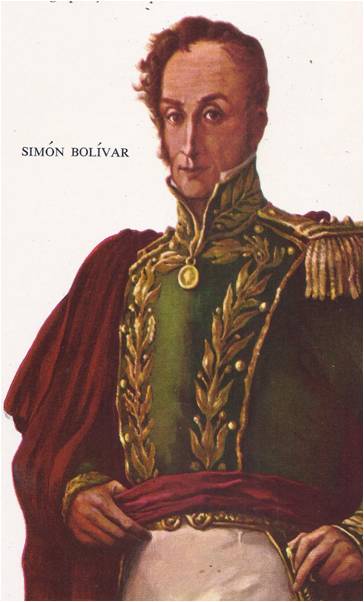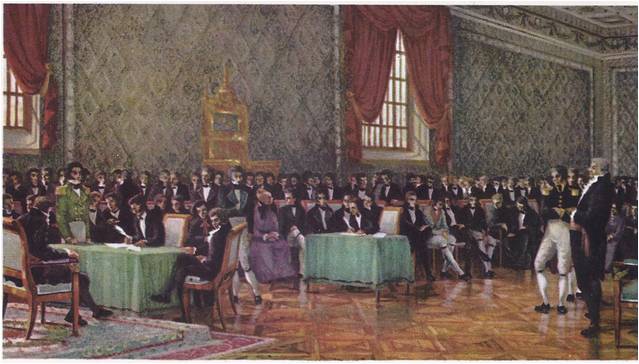DURING THE years when Napoleon and Spain were at war, Spain’s American colonies began their long fight to win independence from the mother country. Some of the earliest revolts were quickly defeated. The leaders were executed, but their deeds were remembered. In the early 1800’s, the leader of an unsuccessful revolt in Bolivia said, as he faced death: “I die; but the torch which I have lighted no one will be able to extinguish.” Francisco Miranda won fame for his unsuccessful revolt in Venezuela in 1811 and 1812.
In Mexico, an old priest named Miguel Hidalgo, who wanted freedom for the Indians, led a force of 80.000 followers against the Spaniards in 1810. A great battle raged for hours. It seemed that the victory would go to Hidalgo’s forces, until a fire started in the grass near their position. Flames and smoke drove them back and in the confusion, the enemy butchered thousands of the rebels. Hidalgo’s head was cut off and placed in an iron cage as a warning against revolt. Although there were many revolutions, only Haiti, Paraguay and a province of Argentina had won independence from Spain by 1816. A year later José de San Martin of Argentina invaded Chile, using more than 9,000 mules and 1,600 horses to carry his heavy supplies over the Andes Mountains. With a small army of less than 4,000 men, he crossed high mountain passes that were 12,500 feet above sea level. Taking the Spaniards by surprise, he won a great victory at Chacabuco and freed Chile from Spanish rule. Later he invaded Peru and helped that nation, too, win its independence. Another great revolutionary leader, Simon Bolivar of Venezuela, defeated the Spaniards in Venezuela and Colombia and sent one of his armies into Ecuador and into what is now Bolivia to defeat the Spaniards there.
REVOLUTIONS AND DICTATORS
San Martin had little faith in democracy. He believed the people of South America could not rule themselves and hoped that the new nations would be ruled over by European princes. Bolivar, on the other hand, fought for both independence and democracy. His great dream was to bring all the nations of South America together in one vast republic, but the new nations refused to unite and fought frequently among themselves and Bolivar died a bitterly disappointed man.

The successful revolutions of Spain’s South American colonies deeply disturbed Austria, Russia, and Prussia — three of the four great powers that had brought about the defeat of Napoleon and had then formed the quadruple Alliance. Their rulers had been badly frightened by the French Revolution and were afraid that a successful revolution anywhere in Europe might spread to other countries. It had therefore been their policy to meet whenever revolution broke out, so that they could take whatever action might be necessary to defeat the rebels and restore order. Now Tsar Alexander of Russia suggested that the three powers meet to consider the revolutions of Spain’s American colonies.
The United States and Britain feared that such a meeting would result in military action by the big European powers against the new Latin American states. The British were firmly against such action. They had been trading with the new nations since they had gained independence and this profitable trade would be lost if Spain were to win back her colonies.
THE MONROE DOCTRINE
The people of the United States, which was also building up a profitable trade with South America, sympathized with the new nations and did not want to see them invaded by European armies. In 1825, President Monroe sent a message to Congress in which he warned the European powers to keep out of the Americas. The Western Hemisphere, he said, should not be considered for “future colonization by any European powers.” This declaration, known as the Monroe Doctrine, came to be a permanent part of the foreign policy of the United States.

In the end, the European powers gave up their plans to invade South America, probably because of their great respect for the British navy, which was then the strongest in the world. The new Latin American nations were thus given a chance to become established without any outside interference from Europe. A number of them were led by revolutionary leaders who had such faith in democracy that they attempted to set up governments similar to that of the United States.
Most of these republics, however, were doomed from the beginning. The great mass of people in most of the new Latin American countries were Indians and Negroes, whom the Spaniards had looked down upon and treated as little better than slaves. Poor, uneducated, superstitious, they lived in widely scattered rural communities. In regions where the farming was good, they worked in the fields of the rich Spanish plantation owners, who had seized the best land. In other regions, they tried to live on what little they could grow on the slopes of mountains or on small fields hacked out of tropical jungles.
Most of them spoke little or no Spanish. Instead, they spoke one of the many native languages, and people who lived in one part of the country had difficulty in communicating with those who lived elsewhere. They knew little of what went on beyond their own communities. They could not read or write and had only a dim understanding of such things as nations, governments and democracy. The right to vote was restricted to wealthy farmers and landowners, businessmen, professional men and office holders who lived in the larger towns and cities — a very small percentage of the total population. Their elected representatives favoured the upper classes and passed laws giving them special privileges and advantages. The rich became richer and the poor had to suffer under ever increasing burdens until they ran out of patience and rose up in rebellion.
So the history of the various Latin American countries followed a familiar pattern — a series of revolutions, one dictator after another, attempts to establish a representative form of government, more revolutions and more dictators. Behind the confusion, other battles were taking place, battles between the conservatives and the liberals, who wanted equality and a better life for all the people, but not for years would the Latin American nations begin to approach true democracy.





